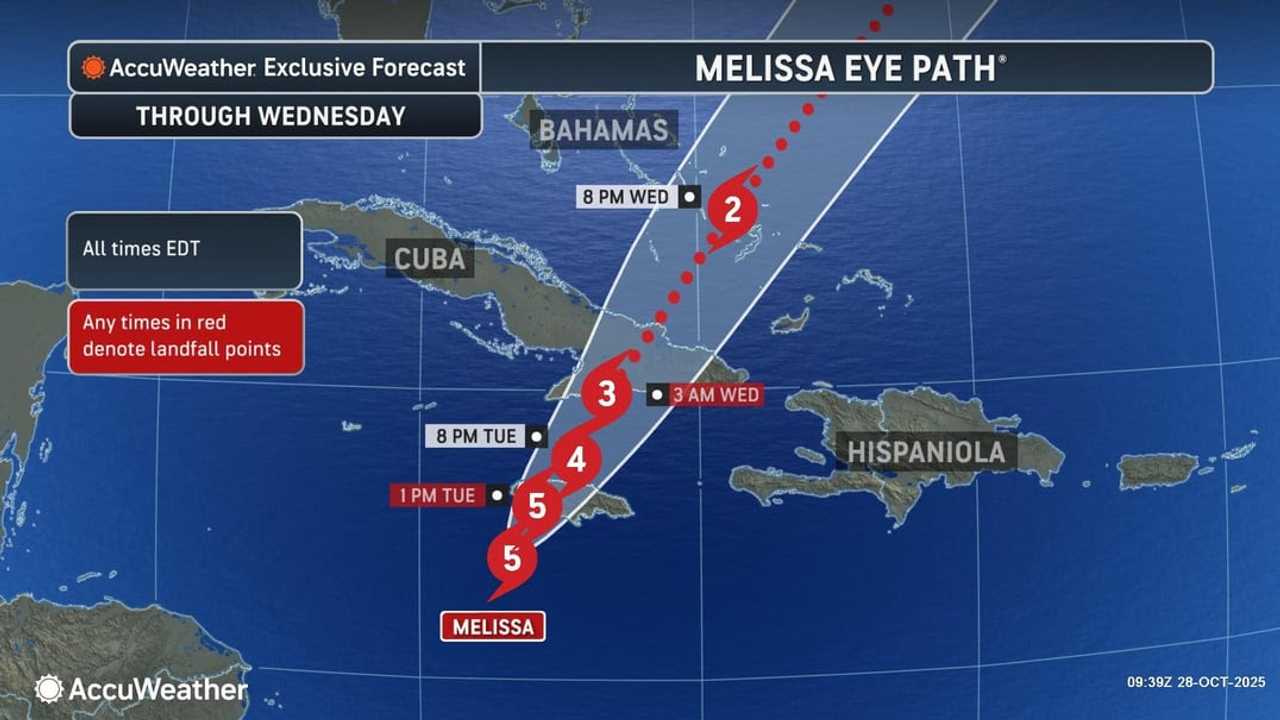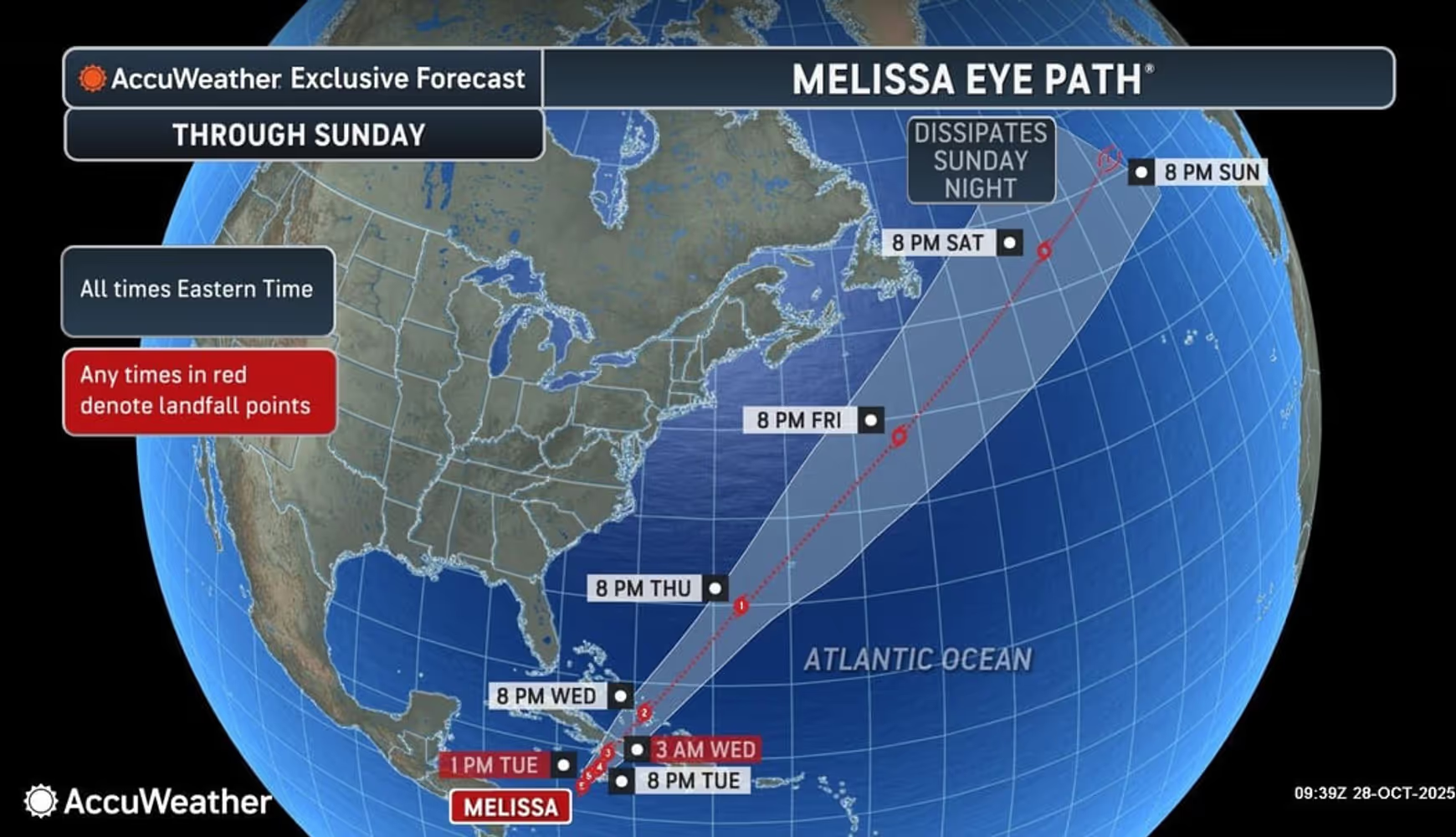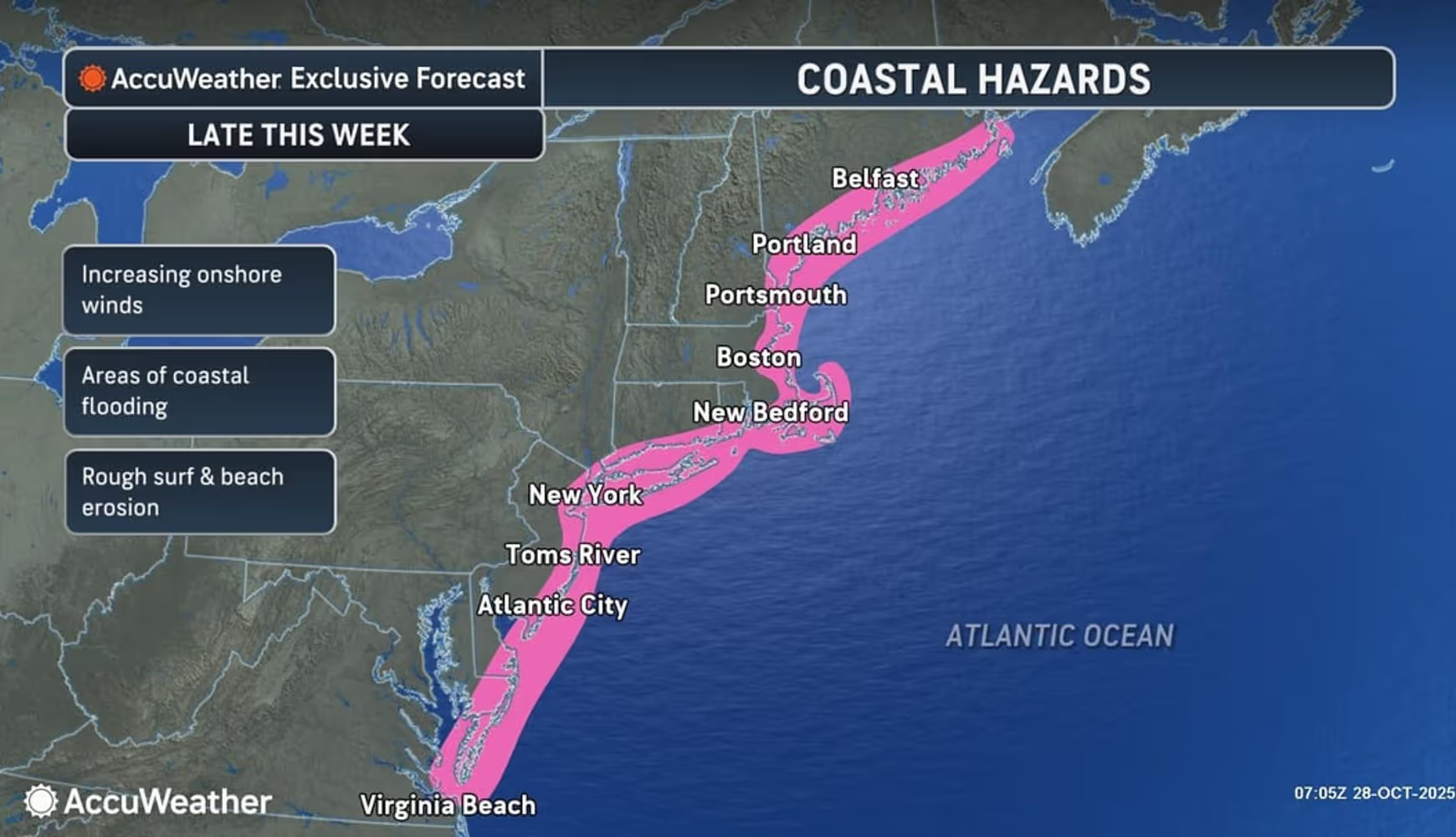
By Joe Lombardi From Daily Voice
Hurricane Melissa, a catastrophic Category 5 storm, has just made landfall in western Jamaica as one of the strongest storms ever.
It's expected to leave behind unprecedented destruction and threatening lives across the island.
With winds near 200 mph, storm surge as high as 18 feet, and rainfall of 3 feet or more, the slow-moving monster will become the strongest storm to ever strike Jamaica in recorded history, the most potent storm of the 2025 hurricane season, and one of the strongest to ever hit the Atlantic basic.
Melissa, moving northeast at just 9 mph, made landfall at around 1 p.m. Tuesday, Oct. 28. Its 185 mph winds made it a Cat 5 storm at landfall.
Official landfall came when the approximately 20-mile eye of the hurricane crossed the coastline in southwestern Jamaica, near New Hope, and on a straight path toward Montego Bay, which is on the island's northern coast. Melissa will then be headed to eastern Cuba, the Bahamas, and then Bermuda.
“This is an extremely dangerous and life-threatening situation! Take cover now!” the National Hurricane Center warned in an urgent message posted late Tuesday morning, Oct. 28.
Devastating Impacts Across Jamaica
The impacts of Hurricane Melissa are being described as catastrophic by meteorologists and local officials. AccuWeather Chief Meteorologist Jonathan Porter issued a stark warning about the storm’s destructive potential.
“The intense storm surge, extreme rain, and destructive winds can damage critical infrastructure across Jamaica,” Porter said. “A catastrophic storm surge up to 18 feet is possible, just east of where the storm makes landfall.
"Key power plants, water treatment facilities, airports, shipping ports, and fuel terminals are all at risk of extensive damage or destruction in the hardest hit areas.
"Especially in the areas where the core of the destructive winds travel, from south to north across the island, some communities may be unrecognizable given the level of catastrophic damage.”
The eyewall of the storm, which delivers the highest winds, is producing impacts comparable to an EF-3 or EF-4 tornado, AccuWeather Meteorologist Brandon Buckingham explained.
“Along the path of Melissa’s eyewall, wind gusts can be comparable to that of an EF-3 or EF-4 tornado, which can essentially level anything in its path,” Buckingham said. “Wind gusts of this magnitude can last for hours, especially in areas that do not experience a brief break in the eye of the storm. This zone of catastrophic wind gusts can span 20 to 30 miles wide and extend from the southern shores to the northern shores of Jamaica.”
Deadly Destruction, Flooding
AccuWeather experts say Melissa’s slow movement across Jamaica is amplifying the storm’s deadly impacts.
Prolonged heavy rainfall is triggering life-threatening flooding and mudslides, particularly in mountainous regions.
“People across Jamaica are facing the most extreme hurricane impacts the island has ever experienced in recorded history,” AccuWeather Lead Hurricane Expert Alex DaSilva said. “The catastrophic wind speeds combined with the slow forward motion of this storm are a deadly and destructive combination.
"The uplifting motion forcing moisture-filled air over the mountains will squeeze out extreme amounts of rain. Some areas could see more than 3 feet of rainfall.
"Life-threatening flooding and mudslides will worsen as Melissa treks across the island. The destruction could be unlike anything people in Jamaica have seen before. The island has never taken a direct hit from a Category 4 or a Category 5 hurricane in recorded history.”
DaSilva also warned that the storm’s impacts will make recovery efforts extraordinarily difficult.
“Roads and bridges could be washed away. Communities could be left completely cut off without power, communication, clean drinking water, or roads to get in and out,” he said. “Rescues will be virtually impossible during the peak of the storm impacts. Search, rescue, and recovery operations will be incredibly challenging and dangerous after the storm passes.”
Recovery Could Take Years
Experts believe the road to recovery in Jamaica will be long and difficult. Mudslides, washed-out roads, and impassable bridges could isolate communities for weeks or months, leaving survivors without access to essential resources.
“This is a long-duration disaster,” Porter said. “Conditions will be incredibly dangerous after the storm passes. Mudslides and washouts could leave many roads and bridges impassible for weeks or possibly months across Jamaica.
"A coordinated international response will be needed to help hurricane survivors across the western Caribbean. Parts of Haiti and the Dominican Republic could face more flooding after days of heavy rainfall. The recovery may take up to a decade or longer in the hardest hit areas.”
US Coastal Impact
The US East Coast is expected to experience onshore winds, coastal flooding, rough surf, and beach erosion later this week, particularly if Melissa grows larger in size.
What’s Next
Relief efforts will likely require significant international aid, and experts warn that the full scale of the damage may not be known for days or even weeks.
Already Among Historic Storms
According to the Weather Channel, Melissa is already at a lowest-pressure level that puts it among the most powerful Atlantic hurricanes ever.
It's a list that also includes No. 1 Wilma (2005 with a pressure or mb of 882), No. 2 Gilbert (1988, 888 mb), and No. 4 Rita (2005, 895 mb). In fact, the group also includes a storm when names were not assigned, No. 3 Labor Day in 1935 (892 mb, which was Melissa's pressure at landfall.)
Check back to Daily Voice for updates.

 Daily Voice
Daily Voice


 Gizmodo
Gizmodo WTAJ-TV
WTAJ-TV Q105.7 & 103.5
Q105.7 & 103.5 New York Post
New York Post People Crime
People Crime Gothamist
Gothamist WFVX WVII News
WFVX WVII News Newsday
Newsday amNewYork
amNewYork FOX 29 New Jersey
FOX 29 New Jersey Brooklyn Paper
Brooklyn Paper Raw Story
Raw Story